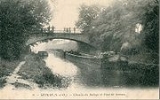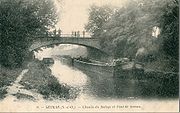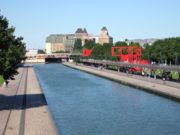
Canal de l'Ourcq
Encyclopedia

Paris Basin
Paris Basin may refer to:*As a hydrological basin, it is largely the basin of the River Seine* Paris Basin , the geological basin...
with 10 locks. It was built at a width of 3.2 m(10 ft) but was enlarged to 3.7 m (12 ft), which permitted use by more pleasure boats. The canal begins at Port-aux-Perches near the village of Troesnes, where it splits from the channeled River Ourcq
Ourcq
The Ourcq is a 87 km long river in France, right tributary of the Marne. Its source is near the village Ronchères. Its course crosses the departments of Aisne, Oise and Seine-et-Marne. It flows southwest through the towns of Fère-en-Tardenois, La Ferté-Milon, Mareuil-sur-Ourcq and Crouy-sur-Ourcq,...
, and flows to the Bassin de la Villette
Bassin de la Villette
The Bassin de la Villette is the largest artificial lake in Paris. It was filled with water on 2 December 1808. Located in the 19th arrondissement of the capital, it links the Canal de l'Ourcq to the Canal Saint-Martin, and it represents one of the elements of the Réseau des Canaux Parisiens , a...
, where it joins the Canal Saint-Martin
Canal Saint-Martin
Canal Saint-Martin is a 4.5 km long canal in Paris. It connects the Canal de l'Ourcq to the river Seine.-Geography:The entrance of the canal is a double lock near Place de Stalingrad. Then, towards the river Seine, the canal is bordered by the quai de Valmy on one side and the quai de Jemmapes on...
. Paris requires 380 000 m3 (497,000 yd3) of water daily for cleaning the sewer system, gutters, and parks. The Canal de l'Ourcq provides about half of the requirement. Since 1983, the waterway has been designated for use by pleasure craft, and its water is designated for non-drinking uses.
The canal is considered part of the 130 km (80.7 mi) Parisian canal network, along with the Canal Saint-Denis
Canal Saint-Denis
The Canal Saint-Denis is a canal in Paris that is in length. The canal connects the Canal de l'Ourcq, at a point north-northwest of the Bassin de la Villette in the 19th arrondissement, with the suburban municipalities of Saint-Denis and Aubervilliers in the department of Seine-Saint-Denis...
, the bassin de la Villette, and the Canal Saint-Martin
Canal Saint-Martin
Canal Saint-Martin is a 4.5 km long canal in Paris. It connects the Canal de l'Ourcq to the river Seine.-Geography:The entrance of the canal is a double lock near Place de Stalingrad. Then, towards the river Seine, the canal is bordered by the quai de Valmy on one side and the quai de Jemmapes on...
. The creation of the canals is intimately linked to the story of water in Paris.
Geography

Fère-en-Tardenois
Fère-en-Tardenois is a commune in the Aisne department in Picardy in northern France, .-Population:-Personalities:It was the birthplace of Camille Claudel , sculptor and graphic artist.-Sights:...
in the Aisne
Aisne
Aisne is a department in the northern part of France named after the Aisne River.- History :Aisne is one of the original 83 departments created during the French Revolution on 4 March 1790. It was created from parts of the former provinces of Île-de-France, Picardie, and Champagne.Most of the old...
département. The river is canalized in Silly-la-Poterie
Silly-la-Poterie
Silly-la-Poterie is a commune in the Aisne department in Picardy in northern France.-References:*...
. Its water then follows an 87 km (54 mi) course through the valley and empties into the Marne River
Marne River
The Marne is a river in France, a right tributary of the Seine in the area east and southeast of Paris. It is long. The river gave its name to the départements of Haute-Marne, Marne, Seine-et-Marne, and Val-de-Marne....
near Lizy-sur-Ourcq
Lizy-sur-Ourcq
Lizy-sur-Ourcq is a commune in the Seine-et-Marne department in the Île-de-France region in north-central France.-External links:* * * *...
. Pipework diverts the river from Mareuil
Mareuil
Mareuil is the name or part of the name of the following communes in France:* Mareuil, Charente, in the Charente department* Mareuil, Dordogne, in the Dordogne department* Mareuil-Caubert, in the Somme department* Mareuil-en-Brie, in the Marne department...
, where most of the water flows to Paris via the current canal.
The River Ourcq
The first efforts towards engineering the waterway were inspired by the need for firewood for heating in Paris. The Valois and OrléansHouse of Orleans
Orléans is the name used by several branches of the Royal House of France, all descended in the legitimate male line from the dynasty's founder, Hugh Capet. It became a tradition during France's ancien régime for the duchy of Orléans to be granted as an appanage to a younger son of the king...
families owned a large tract of forest, and in 1560 a plan was devised to carry wood via a system of simple locks
Lock (water transport)
A lock is a device for raising and lowering boats between stretches of water of different levels on river and canal waterways. The distinguishing feature of a lock is a fixed chamber in which the water level can be varied; whereas in a caisson lock, a boat lift, or on a canal inclined plane, it is...
. In 1661, Louis XIV allowed tolls to be collected along the Ourcq River, payable to Philippe d'Orléans
Philippe II, Duke of Orléans
Philippe d'Orléans was a member of the royal family of France and served as Regent of the Kingdom from 1715 to 1723. Born at his father's palace at Saint-Cloud, he was known from birth under the title of Duke of Chartres...
.
Potable water in Paris
When Paris was known as LutetiaLutetia
Lutetia was a town in pre-Roman and Roman Gaul. The Gallo-Roman city was a forerunner of the re-established Merovingian town that is the ancestor of present-day Paris...
, the inhabitants of île Saint-Louis
Île Saint-Louis
The Île Saint-Louis is one of two natural islands in the Seine river, in Paris, France . The island is named after King Louis IX of France ....
used water from the Seine
Seine
The Seine is a -long river and an important commercial waterway within the Paris Basin in the north of France. It rises at Saint-Seine near Dijon in northeastern France in the Langres plateau, flowing through Paris and into the English Channel at Le Havre . It is navigable by ocean-going vessels...
. In the Gallo-Roman
Gallo-Roman culture
The term Gallo-Roman describes the Romanized culture of Gaul under the rule of the Roman Empire. This was characterized by the Gaulish adoption or adaptation of Roman mores and way of life in a uniquely Gaulish context...
era, while the montagne Sainte-Geneviève
Montagne Sainte-Geneviève
The Montagne Sainte-Geneviève is a hill on the left Bank of the Seine in the 5th arrondissement of Paris.On the top of the Montagne, one can visit the Panthéon or the Bibliothèque Sainte-Geneviève, which is often full of students from La Sorbonne and other nearby universities...
was occupied, the water quality began to deteriorate and people began to frequent the Roman Baths
Roman Baths
The Roman Baths complex is a site of historical interest in the English city of Bath. The house is a well-preserved Roman site for public bathing....
or public baths.
During the 4th century, construction of the aqueduc d’Arcueil began under Emperor Julian the Apostate
Julian the Apostate
Julian "the Apostate" , commonly known as Julian, or also Julian the Philosopher, was Roman Emperor from 361 to 363 and a noted philosopher and Greek writer....
. This structure directed water to the Cluny Baths. After the fall of Rome, the aqueducts, to a large extent, were destroyed. For four centuries, from the Merovingian to the Carolingian
Carolingian
The Carolingian dynasty was a Frankish noble family with origins in the Arnulfing and Pippinid clans of the 7th century AD. The name "Carolingian", Medieval Latin karolingi, an altered form of an unattested Old High German *karling, kerling The Carolingian dynasty (known variously as the...
the waters of the Seine were used, mainly from sources at Belleville
Belleville (commune)
Belleville was a French commune in the Seine département lying immediately east of Paris, France. It was one of four communes entirely annexed by the city of Paris in 1860. Its territory is now shared by the XIXe arrondissement and XXe arrondissement, but a neighborhood has retained its name: the...
and Le Pré-Saint-Gervais
Le Pré-Saint-Gervais
Le Pré-Saint-Gervais is a commune in the northeastern suburbs of Paris, France. It is located from the center of Paris. With a density of 23,396 inhabitants per square kilometres at the last French census of 1999, Le Pré-Saint-Gervais is officially the most densely populated municipality in...
. King Philip II
Philip II of France
Philip II Augustus was the King of France from 1180 until his death. A member of the House of Capet, Philip Augustus was born at Gonesse in the Val-d'Oise, the son of Louis VII and his third wife, Adela of Champagne...
, while establishing the Halles de Paris
Les Halles
Les Halles is an area of Paris, France, located in the 1er arrondissement, just south of the fashionable rue Montorgueil. It is named for the large central wholesale marketplace, which was demolished in 1971, to be replaced with an underground modern shopping precinct, the Forum des Halles...
, a sheltered marketplace, had two fountains built in order to aid construction.
By the 18th century, little improvements had been made to bring potable water to Paris. Engineer Pierre-Paul Riquet
Pierre-Paul Riquet
Pierre-Paul Riquet was the engineer and canal-builder responsible for the construction of the Canal du Midi.-Background:...
proposed building a canal from the Ourcq, however his suggestion was not implemented before his death in 1680.
Construction of the canal


Seine
The Seine is a -long river and an important commercial waterway within the Paris Basin in the north of France. It rises at Saint-Seine near Dijon in northeastern France in the Langres plateau, flowing through Paris and into the English Channel at Le Havre . It is navigable by ocean-going vessels...
and bringing water to Paris. Funding was secured via a grant and supplemental wine taxes, and the first stone was laid on 23 September. Napoleon appointed Pierre-Simon Girard to direct the project and work was undertaken in January 1804. The design of the canal called for a structure in which the water was both slowmoving, to aid navigation, and non-stagnant, in order to provide healthy drinking water. The canal was also intended to feed the Canal Saint-Martin
Canal Saint-Martin
Canal Saint-Martin is a 4.5 km long canal in Paris. It connects the Canal de l'Ourcq to the river Seine.-Geography:The entrance of the canal is a double lock near Place de Stalingrad. Then, towards the river Seine, the canal is bordered by the quai de Valmy on one side and the quai de Jemmapes on...
and Canal Saint-Denis
Canal Saint-Denis
The Canal Saint-Denis is a canal in Paris that is in length. The canal connects the Canal de l'Ourcq, at a point north-northwest of the Bassin de la Villette in the 19th arrondissement, with the suburban municipalities of Saint-Denis and Aubervilliers in the department of Seine-Saint-Denis...
. The projected confluence would enable easier navigation through the city centre, as the Seine was not yet dammed, and the canal would provide an alternate route.
Private financiers were awarded the contract to construct and manage the canals. The city of Paris agreed to purchase land and surrender tolls for 99 years to the firms building the canals (the cost of construction was estimated at 6 million francs). Work began in 1805 under Édouard de Villiers du Terrage
Édouard de Villiers du Terrage
Édouard de Villiers du Terrage was a French engineer who together with Jean-Baptiste Prosper Jollois journeyed with Napoleon to Egypt, and prepared the Description de l'Égypte....
. The bassin de la Villette was filled with water on 2 December 1808, and on 15 August 1813 the first boat traveled through the canal. After the fall of the French Empire
First French Empire
The First French Empire , also known as the Greater French Empire or Napoleonic Empire, was the empire of Napoleon I of France...
, work stopped until the Bourbon Restoration
Bourbon Restoration
The Bourbon Restoration is the name given to the period following the successive events of the French Revolution , the end of the First Republic , and then the forcible end of the First French Empire under Napoleon – when a coalition of European powers restored by arms the monarchy to the...
in 1814. The monarchy contracted with the Compagnie Vassel et Saint-Didier for 99 years, which allowed the company to collect tolls along the property, but required that the canal be completed and maintained. It was then realized that the slope was steep, causing too strong a current. Engineer Marie-Émile Vuigner added five locks to make navigation possible. The canal was opened to navigation in 1822.
Under the reign of Napoleon III, water shortages caused boats to become stranded along the canal. In response, authority was given to take water from the Marne
Marne
Marne is a department in north-eastern France named after the river Marne which flows through the department. The prefecture of Marne is Châlons-en-Champagne...
. In 1895 construction began to widen the canal in order for it to accommodate 1,000 tonne vessels. In 1920 this widening was extended to Les Pavillons-sous-Bois
Les Pavillons-sous-Bois
Les Pavillons-sous-Bois is a commune in the eastern suburbs of Paris, France. It is located from the center of Paris.-History:The commune of Les Pavillons-sous-Bois was created on 3 January 1905 by detaching its territory from the commune of Bondy. The name of the commune literally means "the...
. Today the canal provides approximately half of the 380000 cubic metres (497,021.2 cu yd) daily water requirement for the city's public works.
Developments
In February 2005, The Council of Paris launched a study on the construction of a proposed port along the Canal de l'Ourcq. The port would facilitate the transportation of material processed by the waste treatment centre Romainville du Syctom. This would avoid the need for trucks to carry this waste.The port would fulfill the following functions:
- Docking
- Reception, sorting, and shipping of bulky objects
- Service waste containers from the garbage sorting and collection facilities of Romainville

